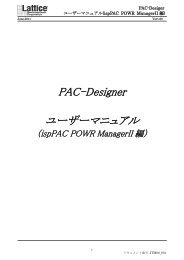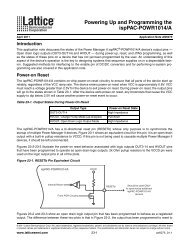DS1036 - Platform Manager Data Sheet - Lattice Semiconductor
DS1036 - Platform Manager Data Sheet - Lattice Semiconductor
DS1036 - Platform Manager Data Sheet - Lattice Semiconductor
You also want an ePaper? Increase the reach of your titles
YUMPU automatically turns print PDFs into web optimized ePapers that Google loves.
Figure 46. Group of Six Programmable I/O Cells<br />
PIO<br />
Six PIOs<br />
This structure is used on the top<br />
and bottom portion of the devices<br />
PIO A<br />
PIO B<br />
PIO C<br />
PIO D<br />
PIO E<br />
PIO F<br />
61<br />
<strong>Platform</strong> <strong>Manager</strong> <strong>Data</strong> <strong>Sheet</strong><br />
The PIO blocks provide the interface between the sysIO buffers and the internal PFU array blocks. These blocks<br />
receive output data from the PFU array and a fast output data signal from adjacent PFUs. The output data and fast<br />
output data signals are multiplexed and provide a single signal to the I/O pin via the sysIO buffer. Figure 47 shows<br />
the FPGA PIO logic.<br />
The PIO receives an input signal from the pin via the sysIO buffer and provides this signal to the core of the FPGA<br />
fabric. In addition there are programmable elements that can be utilized by the design tools to avoid positive hold<br />
times.<br />
PADA "T"<br />
PADB "C"<br />
PADC "T"<br />
PADD "C"<br />
PADE "T"<br />
PADF "C"









